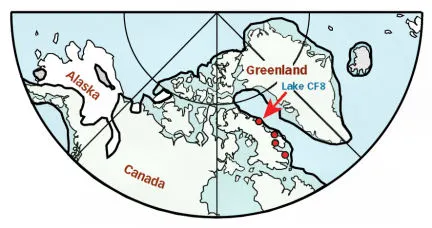Lake-Bottom Bounty: Some Arctic sediments didn’t erode during recent ice ages
The kilometers-thick ice sheets that smothered northeastern Canada and scoured the landscape there during recent ice ages left sediments intact in some locales. This surprising finding could prove a boon to climate researchers.

Most scientists have assumed that the ice sheets that form during ice ages scrape the land clean as they plow across the terrain. Indeed, most of the soil in previously ice-covered arctic areas either formed there since the most recent ice age ended, about 10,000 years ago, or was carried there by wind after the ice sheet disappeared, says Jason P. Briner, a geologist at the State University of New York at Buffalo.
In the past few years, teams of researchers have discovered a few tiny lakes on Canada’s huge, northeastern Baffin Island that contain sediments deposited before the most recent ice age. At first, the scientists theorized that those sites, near the island’s eastern shore and a few hundred meters above sea level, hadn’t been covered by the ice sheet, says Briner. Now, however, research reported by Briner and his colleagues in the October Geology suggests that the ice sheet flowed across those lakes but somehow didn’t clear away their sediments.
The team analyzed core samples from a 0.3-square-kilometer lake on Baffin Island, a 10-meter-deep body of water dubbed Lake CF8 that’s similar to dozens of others in the region, says Briner. In its deposited sediments, thick layers of organic-rich material alternate with thin bands of coarse sand. The uppermost, 1-m-deep layer of carbon-rich sediment was deposited sometime after the end of the most recent ice age. Carbon dating suggests that material at the base of that layer was laid down about 10,500 years ago, says Briner.
Deeper layers of organically rich sediment from the lake are too old to carbon-date, which indicates that those strata are at least 50,000 years old. Other data suggest that the third-deepest and fourth-deepest layers of organic-rich material accumulated beginning about 105,000 years ago and 194,000 years ago, respectively, during warm intervals between ice ages.
The region surrounding Lake CF8 is strewn with boulders, which flowing masses of ice brought in from distant areas during the most recent ice age, says Briner. He and his colleagues suggest that the small lakes froze solid before the ice sheet reached the area, protecting the lake-bottom sediments from the scouring effect of the ice.
Some of the organic material trapped in sediments that the team analyzed includes mosses and algae that lived in the lake as well as fragments of insects—all of which could provide useful clues about the climate in the region (SN: 3/5/05, p. 148).
These sediments “are a time capsule that could go back several hundreds of thousands of years,” says John P. Smol, a biologist at Queen’s University in Kingston, Ontario. “Now, let’s see what’s in there.”







